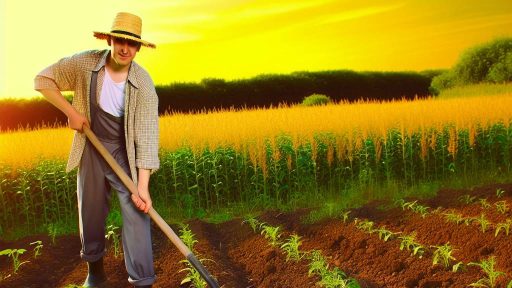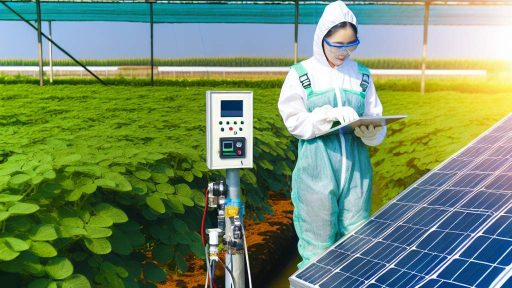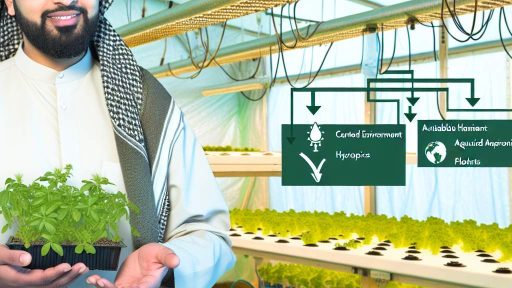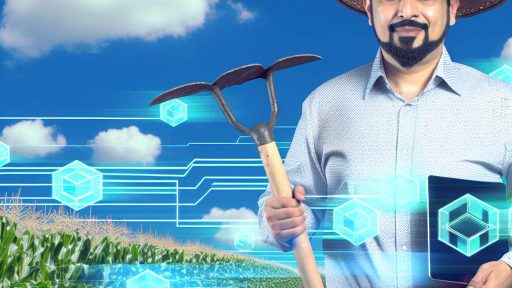Introduction to IoT in Agriculture
The Internet of Things (IoT) reshapes agriculture profoundly.
Farmers now leverage IoT technologies to enhance productivity.
This influx of technology gives rise to data-driven decisions.
As a result, farms become more efficient and sustainable.
Understanding IoT Technology
IoT encompasses various devices connected to the internet.
These devices collect data from the field in real time.
This data can include soil moisture, temperature, and crop health.
Moreover, sensors provide critical insights into farming conditions.
Importance of IoT in Farming
IoT technology optimizes resource management on farms.
This leads to reduced water usage and better fertilizer application.
Consequently, farmers can lower operational costs significantly.
Additionally, IoT enhances crop yield through precise data analysis.
Benefits of IoT for Farmers
Farmers can monitor their crops more effectively.
This monitoring allows for timely intervention when issues arise.
Furthermore, IoT devices help in pest detection and management.
Transform Your Agribusiness
Unlock your farm's potential with expert advice tailored to your needs. Get actionable steps that drive real results.
Get StartedFarmers can make informed decisions based on real-time data.
Future Potential of IoT in Agriculture
The future holds immense potential for IoT in agriculture.
Technological advancements may lead to even smarter solutions.
We could see increased automation in farming tasks.
This shift promises higher productivity and better food security.
Understanding Data Analytics: Techniques and Tools Used in Farming
Introduction to Data Analytics in Agriculture
Data analytics transforms raw data into actionable insights in agriculture.
Farmers increasingly rely on data analytics to enhance productivity.
Moreover, this approach enables better decision-making based on real-time data.
Key Techniques in Data Analytics
Several techniques are pivotal in data analytics for farming.
Predictive analytics forecasts future outcomes based on historical data.
This helps farmers optimize crop yields and resource use.
Descriptive analytics summarizes historical data to identify trends.
Additionally, prescriptive analytics offers recommendations for optimal farming practices.
Tools for Data Collection and Analysis
Numerous tools facilitate data collection and analysis in agriculture.
IoT sensors gather real-time data on soil moisture and weather conditions.
Drones capture aerial images to assess crop health efficiently.
Farm management software integrates data from various sources.
These tools improve data accuracy and enhance decision-making processes.
Benefits of Data Analytics in Farming
Implementing data analytics yields numerous benefits for farmers.
Enhanced crop productivity is one major advantage.
Farmers can also achieve cost savings through resource optimization.
Furthermore, analytics improve risk management strategies.
Consequently, farmers experience increased profitability and sustainability.
Challenges in Implementing Data Analytics
While beneficial, challenges remain in adopting data analytics.
Showcase Your Farming Business
Publish your professional farming services profile on our blog for a one-time fee of $200 and reach a dedicated audience of farmers and agribusiness owners.
Publish Your ProfileData privacy concerns often impede farmers from utilizing analytics fully.
Additionally, the initial costs of technology can be a barrier.
Farmers may also struggle with the complexity of data interpretation.
Training and support are essential to overcome these challenges.
Future Trends in Data Analytics for Agriculture
The future of data analytics in agriculture appears promising.
Machine learning algorithms will further enhance predictive capabilities.
Artificial intelligence will automate data analysis processes.
As a result, farmers will gain even deeper insights into their operations.
Overall, the integration of advanced technologies will redefine farming practices.
Key IoT Devices and Sensors for Gathering Agricultural Data
Soil Moisture Sensors
Soil moisture sensors provide real-time data about soil hydration levels.
This information helps farmers optimize irrigation schedules.
Using these sensors prevents over- or under-watering crops.
Climate Sensors
Climate sensors measure temperature, humidity, and atmospheric pressure.
Farmers use this data to understand local weather patterns.
Informed decisions about planting and harvesting become easier.
Crop Health Sensors
Crop health sensors monitor the condition of plants throughout the growing season.
These sensors can detect nutrient deficiencies or pest infestations early.
Timely interventions can significantly improve yield quality and quantity.
Livestock Monitoring Devices
Livestock monitoring devices track animal health and location.
This technology enhances disease management and ensures better care.
Farmers can monitor feeding habits and breeding cycles effectively.
Agricultural Drones
Agricultural drones facilitate aerial surveillance of vast fields.
They provide detailed imagery for crop health assessments.
Drones help farmers analyze land use and optimize resource allocation.
Weather Stations
Weather stations collect localized meteorological data for farms.
This data assists in predicting upcoming weather conditions.
Farmers can plan their operational activities accordingly.
Mobile Applications
Mobile applications integrate data from various IoT devices.
Farmers can access information easily from their smartphones.
This accessibility promotes quick decision-making on the farm.
Benefits of IoT Technologies
Implementing IoT technologies leads to more efficient farming practices.
Data-driven decisions enhance productivity and resource management.
Ultimately, these tools contribute to sustainable agriculture.
Learn More: Drones For Efficient Irrigation Management In Farming
The Role of Data Analytics in Enhancing Crop Management and Yield
Understanding Data-Driven Insights
Data analytics can transform farming practices dramatically.
Farmers gain deeper insights into crop management through data.
These insights help them understand growth conditions better.
Consequently, farmers can optimize resource allocation.
Data-driven decisions can lead to increased yields.
Improving Crop Monitoring
Advanced analytics enables real-time crop monitoring.
Showcase Your Farming Business
Publish your professional farming services profile on our blog for a one-time fee of $200 and reach a dedicated audience of farmers and agribusiness owners.
Publish Your ProfileFarmers can use IoT devices to gather crucial data.
This data includes moisture levels, temperature, and nutrient content.
With accurate monitoring, farmers can identify issues promptly.
Thus, they can apply timely interventions.
Enhancing Precision Agriculture
Data analytics plays a vital role in precision agriculture.
This approach tailors farming practices to specific field conditions.
Farmers can apply fertilizers and pesticides more effectively.
Using drones and sensors increases farming efficiency significantly.
Such precision reduces wastage and improves productivity.
Predictive Analytics and Forecasting
Predictive analytics helps farmers forecast crop yields accurately.
This process analyzes historical data and current trends.
Farmers can anticipate market demands and plan accordingly.
By leveraging forecasting, they reduce the risk of surplus or shortage.
Consequently, they can maximize profitability.
Case Studies of Successful Data Analytics Integration
Several farmers have seen improvements through data analytics.
For example, Sarah Greenspan utilized data tools for her cornfields.
She monitored soil health and adjusted irrigation based on data.
As a result, her crop yield increased by 30%.
Moreover, John Reddington implemented drones to survey his vineyards.
He improved pest management and reduced chemical use.
Consequently, John’s overall production quality became premium.
Challenges and Considerations
Despite its benefits, data analytics poses some challenges.
Farmers may face issues related to data integration.
In addition, not all farms have access to advanced technology.
Training for farmers is essential to use these tools effectively.
Moreover, data privacy and security concerns need addressing.
Gain More Insights: Precision Irrigation Systems Enhancing Sustainable Farm Practices
Case Studies: Successful Implementations of IoT-Driven Data Analytics in Farming
Smart Irrigation Systems
Farmers in California successfully implemented smart irrigation solutions.
This system uses IoT sensors to monitor soil moisture levels.
Consequently, it optimizes water usage during critical growing seasons.
Moreover, it significantly reduces water waste and operational costs.
Farmers report higher crop yields due to improved water management.
Precision Agriculture with Drones
Agricultural companies in Iowa are adopting drone technology.
Drones equipped with cameras provide real-time data on crop health.
This capability allows farmers to identify and address issues quickly.
In addition, these insights lead to better resource allocation.
As a result, farmers experience enhanced productivity and lower costs.
Livestock Monitoring Solutions
Farmers in Texas utilize IoT devices for livestock monitoring.
These devices track animal health and behavior remotely.
Real-time data collection improves the overall well-being of the herd.
Showcase Your Farming Business
Publish your professional farming services profile on our blog for a one-time fee of $200 and reach a dedicated audience of farmers and agribusiness owners.
Publish Your ProfileConsequently, cattle losses due to health issues have decreased significantly.
Farmers also benefit from higher meat and milk production levels.
Climate-Smart Farming Practices
In Oregon, farmers use IoT technologies to manage climate impacts.
These systems analyze weather patterns and soil conditions.
Farmers adapt their strategies based on predictive data analytics.
Therefore, they mitigate risks associated with climate variability.
This approach enhances resilience and sustainability in agriculture.
Robotics in Crop Harvesting
Innovative tech startups in Florida have introduced robotics for harvesting.
These robots optimize labor costs by automating the harvesting process.
Additionally, they improve precision and speed during the harvest.
Farmers experience reduced waste and higher efficiency on the farm.
Ultimately, this leads to increased profits for agricultural producers.
Learn More: Economic Advantages Of Growing Genetically Modified Crops

Challenges and Limitations of IoT Data Analytics in Agriculture
Data Security Concerns
IoT devices in agriculture collect vast amounts of data.
This data can include sensitive information about farming practices.
Cybersecurity threats pose significant risks to this data.
Farmers must safeguard their information from malicious attacks.
Additionally, data breaches can undermine trust in IoT solutions.
Integration Issues with Existing Systems
Integrating IoT devices can be challenging for farmers.
Many farms utilize legacy systems that are not compatible.
Seamless data flow between old and new solutions is crucial.
Without proper integration, valuable insights may be lost.
Farmers require adequate training to operate these new technologies.
High Initial Costs
Investing in IoT devices can be expensive for farmers.
Costs include purchasing devices, software, and installation services.
Small-scale farmers may find these expenses prohibitive.
Over time, however, data analytics can lead to cost savings.
Farmers must weigh the initial investment against potential benefits.
Data Overload and Analysis Challenges
IoT devices generate a staggering volume of data daily.
Filtering through this data to find actionable insights is crucial.
Many farmers lack the necessary data analysis skills.
Advanced analytical tools can help, but they often come with a price.
As a result, farmers need support in developing data literacy.
Dependence on Internet Connectivity
IoT systems rely heavily on internet connectivity.
Poor connectivity can limit the effectiveness of IoT solutions.
This is especially true in rural areas with unreliable services.
Farmers may experience delays in data transmission and analysis.
Addressing connectivity issues remains a persistent challenge.
Uncover the Details: The Role Of Biotechnology In Pest Management
Future Trends: The Impact of AI and Machine Learning on IoT-Driven Agriculture
Transforming Data into Insights
AI enhances data collection from various IoT devices in agriculture.
Showcase Your Farming Business
Publish your professional farming services profile on our blog for a one-time fee of $200 and reach a dedicated audience of farmers and agribusiness owners.
Publish Your ProfileWith machine learning, farmers analyze vast data sets quickly.
This technology identifies patterns that aid decision-making.
Farmers can optimize planting, fertilizing, and harvesting schedules.
Consequently, crop yields increase, driving overall productivity.
Predictive Analytics for Sustainability
Machine learning algorithms forecast weather and climate patterns.
Farmers use these predictions to manage water resources efficiently.
For example, they can determine the best irrigation times.
This practice conserves water and enhances crop growth.
AI-driven insights also help minimize pesticide usage.
Automated Farm Management
Automation is transforming task execution in farming.
Robots powered by AI handle repetitive tasks efficiently.
They can plant seeds, monitor crops, and harvest produce.
This technology reduces labor costs and increases accuracy.
As a result, farmers can focus on strategic planning.
Enhancing Supply Chain Efficiency
AI improves transparency and traceability within the supply chain.
Smart contracts enabled by blockchain technology ensure secure transactions.
This approach builds trust among consumers regarding food safety.
Additionally, real-time data helps adjust supply chain routes.
Consequently, food waste decreases, benefiting the environment.
Empowering Farmers with Smart Solutions
Smart devices provide farmers with real-time monitoring capabilities.
This technology alerts farmers to potential issues immediately.
For instance, sensors can detect pest infestations early.
Farmers can then respond promptly to mitigate risks.
As such, overall crop health and quality improve significantly.
Best Practices for Farmers: Integrating IoT Solutions into Current Farming Operations
Understanding IoT Solutions
IoT solutions refer to interconnected devices facilitating data collection and communication.
These devices include sensors, drones, and smart equipment.
Farmers can leverage IoT to enhance productivity and efficiency.
Assessing Current Operations
Evaluate existing farming practices to pinpoint improvement areas.
Identify processes that can benefit from IoT integration.
Collect feedback from team members to understand operational gaps.
Selecting the Right IoT Tools
Choose IoT devices that align with your farming goals.
Consider options like soil moisture sensors and weather stations.
Research available technologies and their proven benefits.
Implementing Pilot Projects
Start small with pilot projects to test your chosen solutions.
This allows farmers to gauge effectiveness without large investments.
Monitor performance and gather data to make informed adjustments.
Training and Skills Development
Provide training sessions for your team on using new technologies.
This ensures everyone understands the devices and their functions.
Encourage ongoing learning to adapt to evolving IoT tools.
Collaboration and Networking
Engage with other farmers who have successfully integrated IoT.
Showcase Your Farming Business
Publish your professional farming services profile on our blog for a one-time fee of $200 and reach a dedicated audience of farmers and agribusiness owners.
Publish Your ProfileShare insights and best practices for mutual benefit.
Join online forums or local agricultural groups focused on IoT advancements.
Monitoring and Evaluation
Continuously monitor the impact of IoT tools on productivity.
Use analytics to assess data and make necessary improvements.
Evaluate results against initial goals and adapt strategies accordingly.
Ensuring Data Security
Implement robust data security measures to protect sensitive information.
Regularly update software to mitigate vulnerabilities.
Educate staff about cybersecurity best practices.
Staying Informed on IoT Innovations
Keep abreast of the latest IoT trends and technologies in agriculture.
Attend industry conferences and webinars to gain insights.
Subscribe to agricultural technology publications for ongoing updates.
Additional Resources
FarmBeats: AI, Edge & IoT for Agriculture – Microsoft Research
Precision Agriculture: Benefits and Challenges for Technology …




